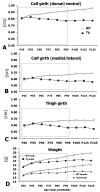Pre-symptomatic detection of chronic motor deficits and genotype prediction in congenic B6.SOD1(G93A) ALS mouse model
- PMID: 19699279
- PMCID: PMC2783710
- DOI: 10.1016/j.neuroscience.2009.08.031
Pre-symptomatic detection of chronic motor deficits and genotype prediction in congenic B6.SOD1(G93A) ALS mouse model
Abstract
Amyotrophic lateral sclerosis (ALS) is an incurable progressive paralytic motor neuron disease with limited therapeutic options. Since their creation by Gurney et al. (1994) [Science 264:1772-1775], transgenic superoxide dismutase-1 with glycine to alanine switch at codon 93 (SOD1(G93A)) mice have become the benchmark pre-clinical model for screening ALS therapies. Surprisingly, despite physiological, anatomical, ultrastructural and biochemical evidence of early motor system dysfunction, it has proven difficult to detect motor performance deficits in pre-symptomatic SOD1(G93A) mice. As an alternative to conventional forced motor tests, we investigated the progression of motor performance deficits in freely behaving pre-symptomatic congenic B6.SOD1(G93A) mice. We found that motor performance deficits began several weeks prior to the onset of overt clinical symptoms (postnatal day 45). More importantly, once motor performance deficits manifested, they persisted in parallel with disease progression. In addition, two physical measures of muscle girth revealed progressive hindlimb muscle atrophy that predicted genotype in individual pre-symptomatic mice with 80% accuracy. Together, these data suggest that muscle girth is a reliable and indirect measure of hindlimb muscle denervation and an early, objective marker for disease onset in congenic B6.SOD1(G93A) ALS mice. Moreover, we present regression equations based on hindlimb muscle girth for predicting genotype in future studies using B6.SOD1(G93A) mice. These findings support new objective criteria for clinical disease onset and provide objective measures that require little expertise. These studies demonstrate a cost-effective approach for more thorough evaluation of neuroprotective strategies that seek to disrupt disease mechanisms early in the disease process. To our knowledge, these findings are the first to report early chronic motor performance and physical deficits that are coincident with the earliest known motor dysfunction in any ALS mouse model.
Figures





Similar articles
-
Comparative Study of Structural and Functional Rearrangements in Skeletal Muscle Mitochondria of SOD1-G93A Transgenic Mice at Pre-, Early-, and Late-Symptomatic Stages of ALS Progression.Front Biosci (Landmark Ed). 2025 Mar 18;30(3):28260. doi: 10.31083/FBL28260. Front Biosci (Landmark Ed). 2025. PMID: 40152389
-
Progressive impairment of CaV1.1 function in the skeletal muscle of mice expressing a mutant type 1 Cu/Zn superoxide dismutase (G93A) linked to amyotrophic lateral sclerosis.Skelet Muscle. 2016 Jun 23;6:24. doi: 10.1186/s13395-016-0094-6. eCollection 2016. Skelet Muscle. 2016. PMID: 27340545 Free PMC article.
-
The effect of peripheral nerve injury on disease progression in the SOD1(G93A) mouse model of amyotrophic lateral sclerosis.Neuroscience. 2005;130(4):897-910. doi: 10.1016/j.neuroscience.2004.09.069. Neuroscience. 2005. PMID: 15652988
-
Unraveling the complexity of amyotrophic lateral sclerosis: recent advances from the transgenic mutant SOD1 mice.CNS Neurol Disord Drug Targets. 2010 Aug;9(4):491-503. doi: 10.2174/187152710791556096. CNS Neurol Disord Drug Targets. 2010. PMID: 20522008 Review.
-
ALS genetic modifiers that increase survival of SOD1 mice and are suitable for therapeutic development.Prog Neurobiol. 2011 Oct;95(2):133-48. doi: 10.1016/j.pneurobio.2011.07.009. Epub 2011 Jul 26. Prog Neurobiol. 2011. PMID: 21816207 Review.
Cited by
-
Dysregulation of astrocyte-motoneuron cross-talk in mutant superoxide dismutase 1-related amyotrophic lateral sclerosis.Brain. 2011 Sep;134(Pt 9):2627-41. doi: 10.1093/brain/awr193. Brain. 2011. PMID: 21908873 Free PMC article.
-
Intravenously Administered, Retinoid Activating Nanoparticles Increase Lifespan and Reduce Neurodegeneration in the SOD1G93A Mouse Model of ALS.Front Bioeng Biotechnol. 2020 Mar 27;8:224. doi: 10.3389/fbioe.2020.00224. eCollection 2020. Front Bioeng Biotechnol. 2020. PMID: 32292776 Free PMC article.
-
Behavioural effects of oral cannabidiol (CBD) treatment in the superoxide dismutase 1 G93 A (SOD1G93 A) mouse model of amyotrophic lateral sclerosis.Psychopharmacology (Berl). 2025 Sep;242(9):2077-2095. doi: 10.1007/s00213-025-06785-z. Epub 2025 Apr 14. Psychopharmacology (Berl). 2025. PMID: 40229540 Free PMC article.
-
Disease-modifying effects of metabolic perturbations in ALS/FTLD.Mol Neurodegener. 2018 Dec 4;13(1):63. doi: 10.1186/s13024-018-0294-0. Mol Neurodegener. 2018. PMID: 30509290 Free PMC article. Review.
-
Clinical testing and spinal cord removal in a mouse model for amyotrophic lateral sclerosis (ALS).J Vis Exp. 2012 Mar 17;(61):3936. doi: 10.3791/3936. J Vis Exp. 2012. PMID: 22453893 Free PMC article.
References
-
- Amendola J, Verrier B, Roubertoux P, Durand J. Altered sensorimotor development in a transgenic mouse model of amyotrophic lateral sclerosis. Eur J Neurosci. 2004;20:2822–2826. - PubMed
-
- Azari MF, Lopes EC, Stubna C, Turner BJ, Zang D, Nicola NA, Kurek JB, Cheema SS. Behavioural and anatomical effects of systemically administered leukemia inhibitory factor in the SOD1(G93A G1H) mouse model of familial amyotrophic lateral sclerosis. Brain Res. 2003;982:92–97. - PubMed
-
- Azzouz M, Krezel W, Dolle P, Vodouhe C, Warter JM, Poindron P, Borg J. Compensatory mechanism of motor defect in SOD1 transgenic mice by overactivation of striatal cholinergic neurons. Neuroreport. 1999;10:1013–1018. - PubMed
-
- Azzouz M, Ralph GS, Storkebaum E, Walmsley LE, Mitrophanous KA, Kingsman SM, Carmeliet P, Mazarakis ND. VEGF delivery with retrogradely transported lentivector prolongs survival in a mouse ALS model. Nature. 2004;429:413–417. - PubMed
-
- Boillee S, Yamanaka K, Lobsiger CS, Copeland NG, Jenkins NA, Kassiotis G, Kollias G, Cleveland DW. Onset and progression in inherited ALS determined by motor neurons and microglia. Science. 2006;312:1389–1392. - PubMed
Publication types
MeSH terms
Substances
Grants and funding
LinkOut - more resources
Full Text Sources
Other Literature Sources
Medical
Molecular Biology Databases
Research Materials
Miscellaneous

